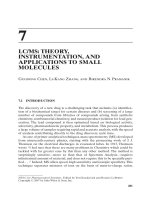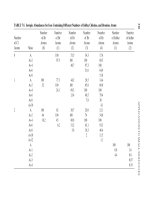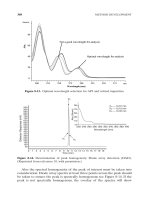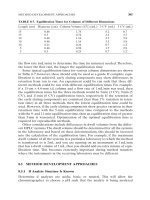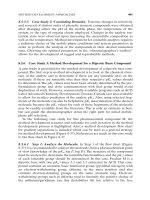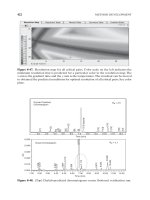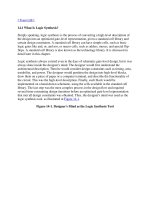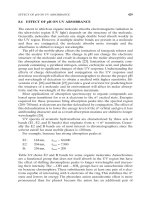Tài liệu HPLC for Pharmaceutical Scientists 2007 (Part 1) docx
Bạn đang xem bản rút gọn của tài liệu. Xem và tải ngay bản đầy đủ của tài liệu tại đây (310.4 KB, 24 trang )
PART I
HPLC THEORY AND PRACTICE
1
INTRODUCTION
Yuri Kazakevich and Rosario LoBrutto
1.1 CHROMATOGRAPHY IN THE PHARMACEUTICAL WORLD
In the modern pharmaceutical industry, high-performance liquid chromatog-
raphy (HPLC) is the major and integral analytical tool applied in all stages of
drug discovery, development, and production. The development of new chem-
ical entities (NCEs) is comprised of two major activities: drug discovery and
drug development. The goal of the drug discovery program is to investigate a
plethora of compounds employing fast screening approaches, leading to gen-
eration of lead compounds and then narrowing the selection through targeted
synthesis and selective screening (lead optimization). This lead to the final
selection of the most potentially viable therapeutic candidates that are taken
forward to drug development. The main functions of drug development
are to completely characterize candidate compounds by performing drug
metabolism, preclinical and clinical screening, and clinical trials. Concomi-
tantly with the drug development process, the optimization of drug synthesis
and formulation are performed which eventually lead to a sound and robust
manufacturing process for the active pharmaceutical ingredient and drug
product. Throughout this drug discovery and drug development paradigm,
rugged analytical HPLC separation methods are developed and are tailored
by each development group (i.e., early drug discovery, drug metabolism,
pharmokinetics, process research, preformulation, and formulation). At each
phase of development the analyses of a myriad of samples are performed to
adequately control and monitor the quality of the prospective drug candidates,
excipients, and final products. Effective and fast method development is of
3
HPLC for Pharmaceutical Scientists, Edited by Yuri Kazakevich and Rosario LoBrutto
Copyright © 2007 by John Wiley & Sons, Inc.
paramount importance throughout this drug development life cycle. This
requires a thorough understanding of HPLC principles and theory which lay
a solid foundation for appreciating the many variables that are optimized
during fast and effective HPLC method development and optimization.
1.2 CHROMATOGRAPHIC PROCESS
Chromatographic separations are based on a forced transport of the liquid
(mobile phase) carrying the analyte mixture through the porous media and
the differences in the interactions at analytes with the surface of this porous
media resulting in different migration times for a mixture components.
In the above definition the presence of two different phases is stated and
consequently there is an interface between them. One of these phases pro-
vides the analyte transport and is usually referred to as the mobile phase, and
the other phase is immobile and is typically referred to as the stationary phase.
A mixture of components, usually called analytes, are dispersed in the mobile
phase at the molecular level allowing for their uniform transport and interac-
tions with the mobile and stationary phases.
High surface area of the interface between mobile and stationary phases is
essential for space discrimination of different components in the mixture.
Analyte molecules undergo multiple phase transitions between mobile phase
and adsorbent surface. Average residence time of the molecule on the sta-
tionary phase surface is dependent on the interaction energy. For different
molecules with very small interaction energy difference the presence of sig-
nificant surface is critical since the higher the number of phase transitions that
analyte molecules undergo while moving through the chromatographic
column, the higher the difference in their retention.
The nature of the stationary and the mobile phases, together with the mode
of the transport through the column, is the basis for the classification of chro-
matographic methods.
1.3 CLASSIFICATION
The mobile phase could be either a liquid or a gas, and accordingly we can
subdivide chromatography into liquid chromatography (LC) or gas
chromatography (GC). Apart from these methods, there are two other modes
that use a liquid mobile phase, but the nature of its transport through the
porous stationary phase is in the form of either (a) capillary forces, as in planar
chromatography (also called thin-layer chromatography, TLC), or (b) elec-
troosmotic flow, as in the case of capillary electrochromatography (CEC).
The next classification step is based on the nature of the stationary phase.
In gas chromatography it could be either a liquid or a solid; accordingly, we
4 INTRODUCTION
distinguish gas–liquid chromatography (long capillary coated with a thin
film of relatively viscous liquid or liquid-like polymer; in older systems,
liquid-coated porous particles were used) and gas–solid chromatography
(capillary with thin porous layer on the walls or packed columns with porous
particles).
In liquid chromatography a similar distinction historically existed, since to
a significant extent the development of liquid chromatography reflected the
path that was taken by gas chromatography development. Liquid–liquid chro-
matography existed in the early 1970s, but was mainly substituted with
liquid chromatography with chemically bonded stationary phases. Recently,
liquid–liquid chromatography resurfaced in the form of countercurrent chro-
matography with two immiscible liquid phases of different densities [1]. The
other form of LC is liquid–solid chromatography.
Liquid chromatography was further diversified according to the type of the
interactions of the analyte with the stationary phase surface and according to
their relative polarity of the stationary and mobile phases.
Since the invention of the technique, adsorbents with highly polar surface
were used (CaCO
3
—Tswett, porous silica—most of the modern packing mate-
rials) together with relatively non-polar mobile phase. In 1964, Horvath intro-
duced a chemically modified surface where polar groups were shielded and
covered with graphitized carbon black and later with chemically bonded alkyl
chains. The introduction of chemically modified hydrophobic surfaces replaces
the main analyte—surface interactions from polar to the hydrophobic ones,
while mobile phase as an analyte carrier became polar. The relative polarity
of the mobile and stationary phases appears to be “reversed” compared to the
historically original polar stationary phase and non-polar mobile phase used
by M. S. Tswet. This new mode of liquid chromatography became coined as
reversed-phase liquid chromatography (RP), where “reversed-phase” referred
to the reversing of the relative polarity of the mobile and stationary phases.
In order to distinguish this mode from the old form of liquid chromatography,
the old became known as normal-phase (NP).
The third mode of liquid chromatography, which is based on ionic interac-
tions of the analyte with the stationary phase, is called ion-exchange (IEX).
The separation in this mode is based on the different affinity of the ionic ana-
lytes for the counterions on the stationary phase surface.
Specific and essentially stand-alone mode of liquid chromatography is asso-
ciated with the absence or suppression of any analyte interactions with the sta-
tionary phase, which is called size-exclusion chromatography (SEC). In SEC
the eluent is selected in such a manner that it will suppress any possible analyte
interactions with the surface, and the separation of the analyte molecules in
this mode is primarily based on their physical dimensions (size).The larger the
analyte molecules, the lower the possibility for them to penetrate into the
porous space of the column packing material, and consequently the faster they
will move through the column. The schematic of this classification is shown in
Figure 1-1.
CLASSIFICATION 5
1.4 HISTORY OF DISCOVERY AND EARLY DEVELOPMENT
(1903–1933)
Chromatography as a physicochemical method for separation of complex
mixtures was discovered at the very beginning of the twentieth century by
Russian–Italian botanist M. S. Tswet. [2]. In his paper “On the new form of
adsorption phenomena and its application in biochemical analysis” presented
on March 21, 1903 at the regular meeting of the biology section of the Warsaw
Society of Natural Sciences, Tswet gave a very detailed description of the
newly discovered phenomena of adsorption-based separation of complex mix-
tures, which he later called “chromatography” as a transliteration from Greek
“color writing” [3]. Serendipitously, the meaning of the Russian word “tswet”
actually means color. Although in all his publications Tswet mentioned that
the origin of the name for his new method was based on the colorful picture
of his first separation of plant pigments (Figure 1-2), he involuntarily incor-
porated his own name in the name of the method he invented.
The chromatographic method was not appreciated among the scientists at
the time of the discovery, as well as after almost 10 years when L. S. Palmer
[4] in the United States and C. Dhere in Europe independently published the
description of a similar separation processes. More information on history of
early discovery and development of chromatography could be found in refer-
ence 5.
Twenty-five years later in 1931, Lederer read the book of L. S. Palmer and
later found an original publications of M. S. Tswett, and in 1931 he (together
with Kuhn and Winterstein) published a paper [6] on purification of
xantophylls on CaCO
3
adsorption column following the procedure described
by M. S. Tswet.
In 1941 A. J. P. Martin and R. L. M. Synge at Cambridge University, in UK
discovered partition chromatography [7] for which they were awarded the
Noble Prize in 1952. In the same year, Martin and Synge published a seminal
paper [8] which, together with the paper of A. T. James and A. J. P. Martin [9],
laid a solid foundation for the fast growth of chromatographic techniques that
soon followed.
6 INTRODUCTION
Figure 1-1. Classification of chromatographic modes.
Chromatography was discovered by Tswet in the form of liquid–solid chro-
matography (LSC), but its development continued for over 50 years primar-
ily in the form of gas chromatography and partially as thin-layer and
liquid–liquid chromatography. Rebirth of liquid chromatography in its modern
form and its enormously fast growth had driven this to be the dominant ana-
lytical technique in the twenty-first century which can be attributed in the most
part to the pioneering work of Prof. C. Horvath at Yale University. In the mid-
1960s Prof. Horvath, who previously worked on the development of a porous
layer open-tubular columns for gas chromatography, had decided to use for
liquid chromatography small glass beads with porous layer on their surface to
facilitate the mass transfer between the liquid phase and the surface. Columns
packed with those beads developed a significant resistance to the liquid flow,
and Prof. Horvath was forced to build an instrument that allowed develop-
ment of a continuous flow of the liquid through the column [11]. This was the
origin of high-performance liquid chromatography (HPLC), and the actual
name for this separation method was introduced by Prof. Horvath in 1970 at
the Twenty-first Pittsburgh Conference in Cleveland, where he gave this title
HISTORY OF DISCOVERY AND EARLY DEVELOPMENT (1903–1933) 7
Figure 1-2. Tswet’s original drawings of his experiments. From M. S. Tswet,
“Chromophils in the plant and animal world” [10]. See color plate.
to his invited talk. Later in 2001, he further defined the meaning of the word
“performance” as “an aggregate of the efficiency parameters” shown in
Figure 1-3.
The first separation on a chemically modified surface with an aqueous
eluent, which later got the name “reversed-phase,” was also invented by
Horvath Figure 1-4, he demonstrated the first reversed-phase separation of
fatty acids on pellicular glass beads covered with graphitized carbon black.
1.5 GENERAL SEPARATION PROCESS
M. S.Tswet defined the fractional adsorption process, with the explanation that
molecules of different analytes have different affinity (interactions) with the
adsorbent surface, and analytes with weaker interactions are less retained [3].
In modern high-performance liquid chromatography the separation of
the analytes is still based on the differences in the analyte affinity for the
8 INTRODUCTION
Figure 1-3. Components of performance as defined by C. Horvath. (Reprinted from
reference 12, with permission.)
Figure 1-4. Separation of fatty acids on pellicular graphitized carbon black from the
mixture of ethanol and 10
−4
M aqueous NaOH. Refractive index detection. (Reprinted
from reference 13, with permission.)
stationary phase surface, and the original definition of the separation process
given at its inception almost 100 years ago still holds true.
Liquid chromatography has come a long way with regard to the practical
development of HPLC instrumentation and the theoretical understanding of
different mechanisms involved in the analyte retention as well as the devel-
opment of adsorbents with different geometries and surface chemistry.
1.5.1 Modern HPLC Column
The separation of analyte mixtures in modern HPLC is performed in the
device called the “column.” Current HPLC columns in most cases are a stain-
less steel tube packed with very small (1–5µm) particles of rigid porous mate-
rial. Packing material is retained inside the column with special end-fittings
equipped with porous frits allowing for liquid line connection (to deliver
mobile phase to the column). Stainless steel or titanium frits have a pore size
on the level of 0.2–0.5µm, which allows for the mobile phase to pass through
while small particles of packing material are retained inside the column.
The column is the “heart” of the chromatographic system; and it is the only
device where actual separation of the analyte mixture takes place. Detailed
discussion of HPLC columns and stationary phases is given in chapter 3.
1.5.2 HPLC System
Typical HPLC system consists of the following main components:
Solvent Reservoirs. Storage of sufficient amount of HPLC solvents for con-
tinuous operation of the system. Could be equipped with an online
degassing system and special filters to isolate the solvent from the influ-
ence of the environment.
Pump. This provides the constant and continuous flow of the mobile phase
through the system; most modern pumps allow controlled mixing of dif-
ferent solvents from different reservoirs.
Injector. This allows an introduction (injection) of the analytes mixture into
the stream of the mobile phase before it enters the column; most modern
injectors are autosamplers, which allow programmed injections of dif-
ferent volumes of samples that are withdrawn from the vials in the
autosampler tray.
Column. This is the heart of HPLC system; it actually produces a separa-
tion of the analytes in the mixture.A column is the place where the mobile
phase is in contact with the stationary phase, forming an interface with
enormous surface. Most of the chromatography development in recent
years went toward the design of many different ways to enhance this
interfacial contact (a detailed discussion is given in Chapter 3).
Detector. This is a device for continuous registration of specific physical
(sometimes chemical) properties of the column effluent. The most
GENERAL SEPARATION PROCESS 9

